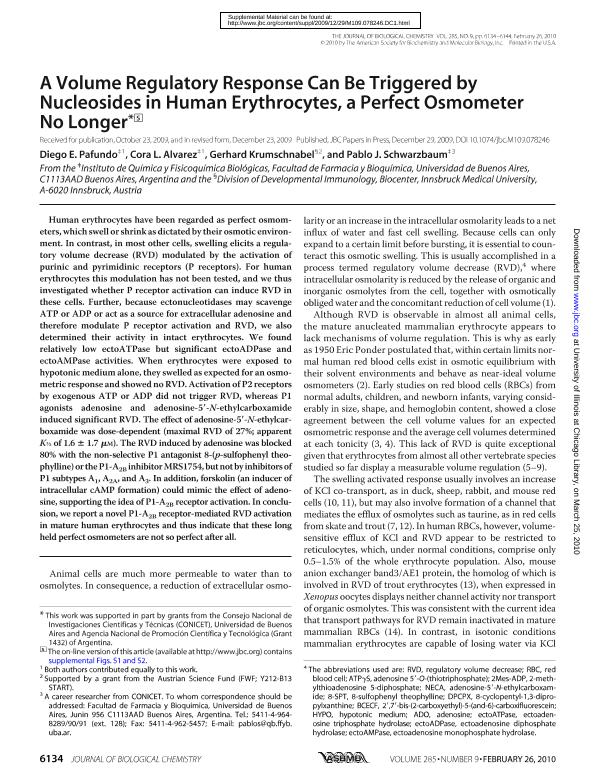Mostrar el registro sencillo del ítem
dc.contributor.author
Pafundo, Diego Esteban

dc.contributor.author
Alvarez, Cora Lilia

dc.contributor.author
Krumschnabel, Gerhard

dc.contributor.author
Schwarzbaum, Pablo Julio

dc.date.available
2017-06-15T16:16:42Z
dc.date.issued
2010-02
dc.identifier.citation
Pafundo, Diego Esteban; Alvarez, Cora Lilia; Krumschnabel, Gerhard; Schwarzbaum, Pablo Julio; A volume regulatory response can be triggered by nucleosides in human erythrocytes, a perfect osmometer no longer; American Society for Biochemistry and Molecular Biology; Journal of Biological Chemistry; 285; 9; 2-2010; 6134-6144
dc.identifier.issn
0021-9258
dc.identifier.uri
http://hdl.handle.net/11336/18250
dc.description.abstract
Human erythrocytes have been regarded as perfect osmometers, which swell or shrink as dictated by their osmotic environment. In contrast, in most other cells, swelling elicits a regulatory volume decrease (RVD) modulated by the activation of purinic and pyrimidinic receptors (P receptors). For human erythrocytes this modulation has not been tested, and we thus investigated whether P receptor activation can induce RVD in these cells. Further, because ectonucleotidases may scavenge ATP or ADP or act as a source for extracellular adenosine and therefore modulate P receptor activation and RVD, we also determined their activity in intact erythrocytes. We found relatively low ectoATPase but significant ectoADPase and ectoAMPase activities. When erythrocytes were exposed to hypotonic medium alone, they swelled as expected for an osmometric response and showed no RVD. Activation of P2 receptors by exogenous ATP or ADP did not trigger RVD, whereas P1 agonists adenosine and adenosine-5′-N-ethylcarboxamide induced significant RVD. The effect of adenosine-5′-N-ethylcarboxamide was dose-dependent (maximal RVD of 27%; apparent K½ of 1.6 ± 1.7 μM). The RVD induced by adenosine was blocked 80% with the non-selective P1 antagonist 8-(p-sulfophenyl theophylline) or the P1-A2B inhibitor MRS1754, but not by inhibitors of P1 subtypes A1, A2A, and A3. In addition, forskolin (an inducer of intracellular cAMP formation) could mimic the effect of adenosine, supporting the idea of P1-A2B receptor activation. In conclusion, we report a novel P1-A2B receptor-mediated RVD activation in mature human erythrocytes and thus indicate that these long held perfect osmometers are not so perfect after all.
dc.format
application/pdf
dc.language.iso
eng
dc.publisher
American Society for Biochemistry and Molecular Biology

dc.rights
info:eu-repo/semantics/openAccess
dc.rights.uri
https://creativecommons.org/licenses/by/2.5/ar/
dc.subject
Rvd
dc.subject
Volume Regulation
dc.subject
Water Transport
dc.subject
Nucleotide Metabolism
dc.subject
Cell/Blood
dc.subject
Cellular Regulation
dc.subject
Erythrocyte
dc.subject
Purinergic Agonists
dc.subject
Purinergic Receptor
dc.subject
P1 Receptor
dc.subject
Extracellular Adenosine
dc.subject
Fluorescence
dc.subject.classification
Biofísica

dc.subject.classification
Ciencias Biológicas

dc.subject.classification
CIENCIAS NATURALES Y EXACTAS

dc.title
A volume regulatory response can be triggered by nucleosides in human erythrocytes, a perfect osmometer no longer
dc.type
info:eu-repo/semantics/article
dc.type
info:ar-repo/semantics/artículo
dc.type
info:eu-repo/semantics/publishedVersion
dc.date.updated
2017-06-14T14:35:15Z
dc.identifier.eissn
1083-351X
dc.journal.volume
285
dc.journal.number
9
dc.journal.pagination
6134-6144
dc.journal.pais
Estados Unidos

dc.journal.ciudad
Bethesda
dc.description.fil
Fil: Pafundo, Diego Esteban. Consejo Nacional de Investigaciones Científicas y Técnicas. Oficina de Coordinación Administrativa Houssay. Instituto de Química y Físico-Química Biológicas "Prof. Alejandro C. Paladini". Universidad de Buenos Aires. Facultad de Farmacia y Bioquímica. Instituto de Química y Físico-Química Biológicas; Argentina
dc.description.fil
Fil: Alvarez, Cora Lilia. Consejo Nacional de Investigaciones Científicas y Técnicas. Oficina de Coordinación Administrativa Houssay. Instituto de Química y Físico-Química Biológicas "Prof. Alejandro C. Paladini". Universidad de Buenos Aires. Facultad de Farmacia y Bioquímica. Instituto de Química y Físico-Química Biológicas; Argentina
dc.description.fil
Fil: Krumschnabel, Gerhard. Universidad de Innsbruck; Austria
dc.description.fil
Fil: Schwarzbaum, Pablo Julio. Consejo Nacional de Investigaciones Científicas y Técnicas. Oficina de Coordinación Administrativa Houssay. Instituto de Química y Físico-Química Biológicas "Prof. Alejandro C. Paladini". Universidad de Buenos Aires. Facultad de Farmacia y Bioquímica. Instituto de Química y Físico-Química Biológicas; Argentina
dc.journal.title
Journal of Biological Chemistry

dc.relation.alternativeid
info:eu-repo/semantics/altIdentifier/doi/http://dx.doi.org/10.1074/jbc.M109.078246
dc.relation.alternativeid
info:eu-repo/semantics/altIdentifier/url/http://www.jbc.org/content/285/9/6134.long
dc.relation.alternativeid
info:eu-repo/semantics/altIdentifier/url/https://www.ncbi.nlm.nih.gov/pmc/articles/PMC2825408/
Archivos asociados
